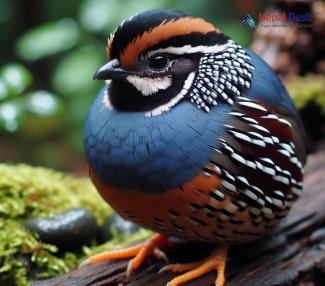The Asian Blue Quail, scientifically known as Synoicus chinensis, and alternatively also blue-breasted quail, King quail, Chinese painted quail, or Chung-Chi, is a species of Old World quail in the family Phasianidae and the smallest "true quail". Native to the beautiful landscapes of Nepal, these small, intriguing birds have distinct characteristics that make them an exciting subject for birdwatchers and naturalists alike. In this article, we will explore the habitat, behavior, and conservation efforts surrounding the Asian Blue Quail in Nepal.
Nesting in Nepal's Natural Beauty
Nepal, a country known for its breathtaking scenery and diverse wildlife, provides an ideal habitat for the Asian Blue Quail. These ground-dwelling birds prefer grasslands and areas with dense shrubbery. They can often be found in meadows, agricultural land, and on the edges of forests where they seek cover from predators and find ample food sources.
Behavior and Communication Among Asian Blue Quail
Asian Blue Quails are generally elusive creatures that rely on their cryptic plumage to remain hidden from potential threats. These birds are most active during early morning and late afternoon when they forage for seeds and insects. The breeding season spans from March to September when males are known to produce soft whistling calls as a form of courtship.
Males exhibit polygamous tendencies and may mate with multiple females during a single breeding season. After mating, females build nests on the ground using dry grasses and leaves. The clutch size typically ranges from 6 to 12 eggs which are incubated by the female alone.
Conservation Efforts in Nepal
Although the Asian Blue Quail is still relatively abundant throughout its range, it faces several threats that could jeopardize its future stability. Habitat degradation due to agriculture expansion, illegal hunting, and climate change all have an impact on these birds' survival rates.
Fortunately, various conservation efforts are being implemented to protect these delicate birds. Initiatives by national parks like Chitwan National Park and Annapurna Conservation Area help maintain and improve natural habitats for the continued survival of the Asian Blue Quail. Researchers and bird enthusiasts also play a role in monitoring and surveying the species, providing essential data to further conservation efforts.
Experiencing the Asian Blue Quail in Nepal
For those interested in witnessing the secretive world of the Asian Blue Quail, Nepal offers an unforgettable experience. To catch a glimpse of these elusive birds, join guided birdwatching tours or engage with local communities that can provide valuable insights into Nepal's rich avian diversity.
Conclusion
The Asian Blue Quail is a fascinating species that calls the stunning landscapes of Nepal its home. By understanding their unique behavior and supporting ongoing conservation efforts, we can ensure that future generations will be able to enjoy the presence of these captivating birds for years to come.




